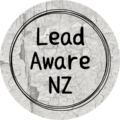DIY Lead Testing
Lead testing swabs (Leadcheck, Scitus, iQuip) are fantastic tools for checking your house paint and possibly other items for lead. But it’s important to know their limitations. They can generally detect down to 600ppm lead on the surface of the tested item. This is a good sensitivity level for paint but not for items used by children or for food. Read more below.
Paint
They are always 100% good for testing paint. But you need to either score the paint with a knife or test worn/chipped areas to make sure you can test the bottom-most layers of paint. The top layers are usually lead-free.
Ceramics
DIY swabs can not necessarily detect high amounts of lead in ceramics. Because of the high detection limit of the tests (relative to food use) there could be a hazardous amount of lead coming out of the surface but still less than the 600ppm threshold of the test. So, a positive result means there is a LOT of lead leaching out, but… A negative result does NOT mean the item is safe.
Toys
Like ceramics, there may be hazardous levels of lead in a toy but may return a negative swab result. 90 ppm lead is considered dangerous to children but the swabs can only detect 600ppm. A negative result does not mean the toy is safe. But a positive definitely shows a toy is unsafe.
Metal items
The chemical in the swabs that reacts with lead also reacts with some other metals like zinc and barium. Metal items can not be reliably tested with DIY swabs. Sometimes they turn black. Sometimes they show positive results when in fact they are lead free but high in zinc.
